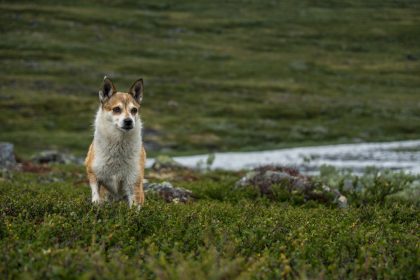
That the Norwegian Lundehund is a physically fascinating breed is an understatement. Highly flexible shoulder joints allow a Lundehund to extend her front legs out to her sides at a 90-degree angle, somewhat similar to doing a split. Additionally, a Lundehund is polydactyl, which means she has six toes on each of her feet, not four toes found in most other breeds. But of all her unique traits, perhaps the one that elicits the most alarm among novices to the breed when it is demonstrated is what she can do with her neck:
In addition to being able to rotate her neck 180 degrees, a Lundehund can bend her head backward to touch her spine which, to the uninitiated, can evoke squeals of concern. This remarkable ability is primarily due to its “double-jointed neck,” a feature that is not commonly found in other canines (some sources write that the New Guinea Singing Dog, Bornean Dingo, and Australian Dingo exhibit similar flexibility in their necks).
What does a “double jointed neck” actually mean?
We digress for a moment to explain that the term, “double-jointed,” when referring to the Lundehund’s neck is a bit of a misnomer. The Lundehund does not actually have “double joints” in the traditional sense. Instead, she has a less pronounced ridge on the atlas vertebra, and this means that it does not make contact with the occipital bone at the back of her skull as it would in other dogs. It is this anatomical feature that allows the Lundehund to bend her head backward to touch her spine, a spectacular “party trick” that is sometimes demonstrated to an astonished audience at a venue like a “Meet the Breeds” event. It does not harm the dog when done “naturally,” which is to say it is best demonstrated by the dog’s owner who can gently show the trait.
Like her flexible shoulder joints and six toes, these structural features are adaptive traits that evolved over centuries. They enable the dog to perform its job as a hunter and retriever of Puffins from slippery cliffs, tight cracks and crevices, and tunnels found in vertical seaside cliffs on remote islands of northern Norway.
Despite our flippant reference to the Lundehund’s features as “party tricks,” did you know that in a dog show setting, a judge should never ask the dog’s handler to demonstrate the dog’s characteristic flexibility in the ring? This isn’t a suggestion. It’s written in the AKC breed standard. As some dogs cannot relax sufficiently at a dog show, it is a wise passage to include.
Image of Norwegischer Lundehund by Marielle/Adobe
